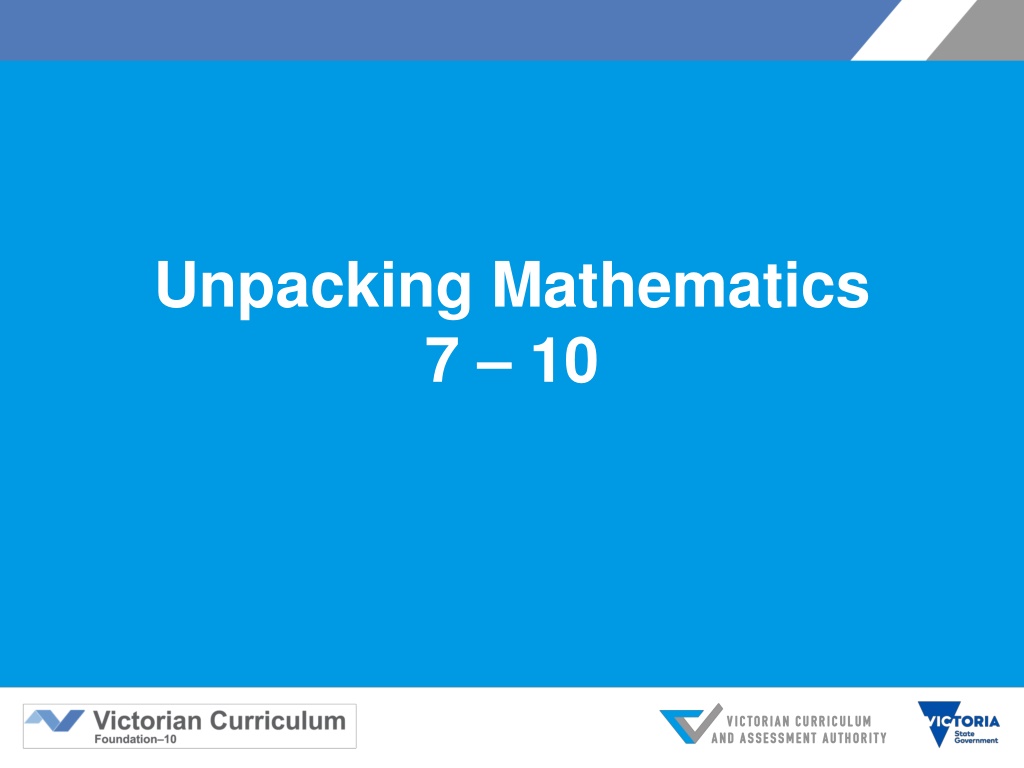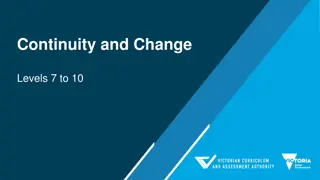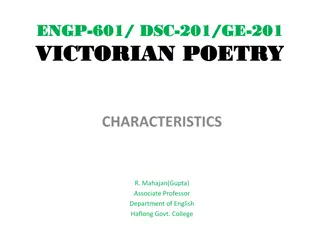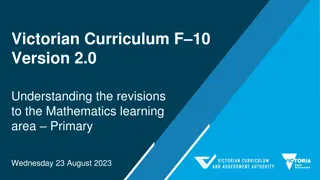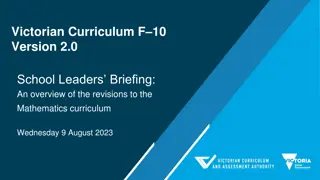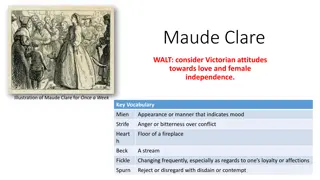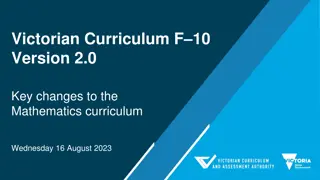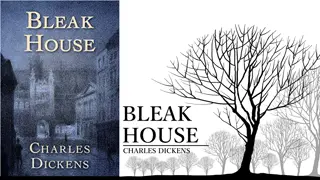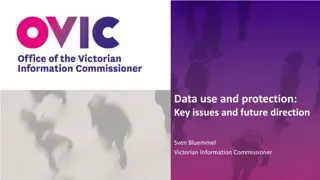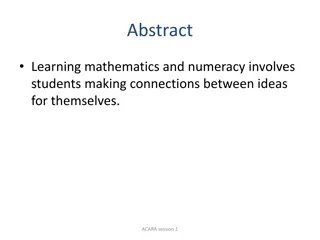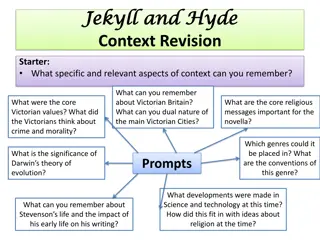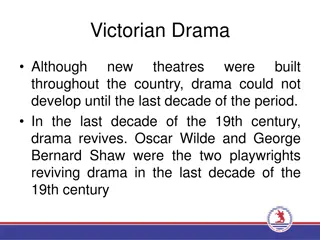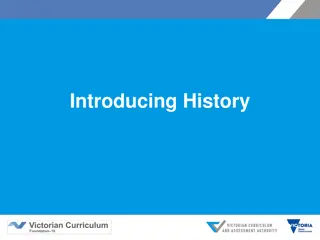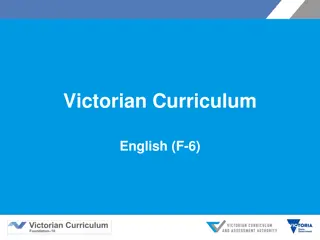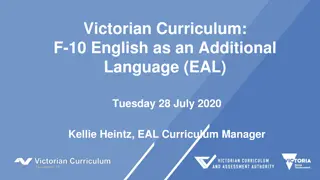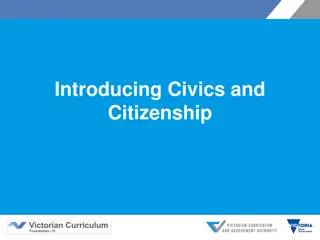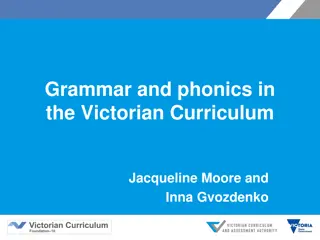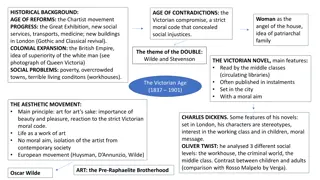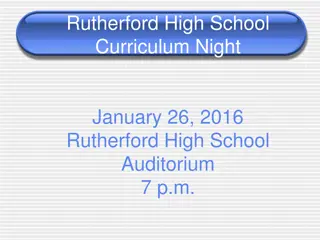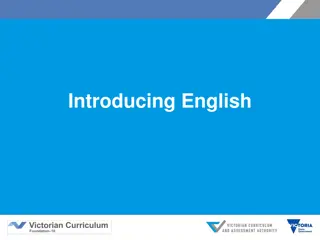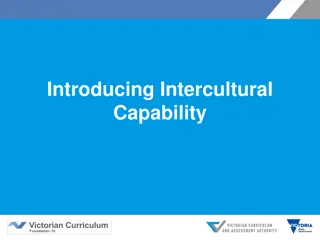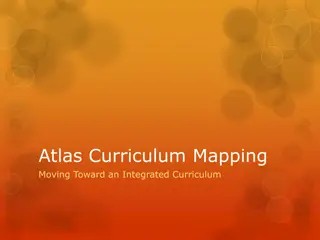Overview of Victorian Curriculum Mathematics F-10
The Victorian Curriculum Mathematics F-10 provides a comprehensive framework for the development of mathematical skills from Foundation to Level 10, incorporating the Australian Curriculum while reflecting Victorian priorities and standards. It aims to equip students with essential numeracy skills for everyday life, emphasize problem-solving across disciplines, and foster a deep appreciation for mathematics. The curriculum includes strands such as Number and Algebra, Measurement and Geometry, and Statistics and Probability, along with achievement standards that cater to different learning levels, including an optional Level 10A. The structure and content of the curriculum remain fundamentally similar to AusVELS Mathematics.
Uploaded on Sep 22, 2024 | 1 Views
Download Presentation

Please find below an Image/Link to download the presentation.
The content on the website is provided AS IS for your information and personal use only. It may not be sold, licensed, or shared on other websites without obtaining consent from the author.If you encounter any issues during the download, it is possible that the publisher has removed the file from their server.
You are allowed to download the files provided on this website for personal or commercial use, subject to the condition that they are used lawfully. All files are the property of their respective owners.
The content on the website is provided AS IS for your information and personal use only. It may not be sold, licensed, or shared on other websites without obtaining consent from the author.
E N D
Presentation Transcript
Overview of session Overview and summary of changes Victorian Curriculum Foundation 10 website Algorithms and coding Sample activities Questions
Victorian Curriculum F10 Released in September 2015 as a central component of the Education State Provides a stable foundation for the development and implementation of whole-school teaching and learning programs The Victorian Curriculum F 10 incorporates the Australian Curriculum and reflects Victorian priorities and standards http://victoriancurriculum.vcaa.vic.edu.au/
Aims The Mathematics curriculum aims to ensure that students: develop useful mathematical and numeracy skills for everyday life, work and as active and critical citizens in a technological world see connections and apply mathematical concepts, skills and processes to pose and solve problems in mathematics and in other disciplines and contexts acquire specialist knowledge and skills in mathematics that provide for further study in the discipline appreciate mathematics as a discipline its history, ideas, problems and applications, aesthetics and philosophy.
Structure Strands and sub-strands (no change) Number and Algebra Measurement and Geometry Using units of measurement Shape Statistics and Probability Number and place value Chance Fractions and decimals Data representation and interpretation Real numbers Money and financial mathematics Patterns and algebra Geometric reasoning Location and transformation Pythagoras and trigonometry Linear and non-linear relationships
Structure Achievement standards The first achievement standard at Foundation and then at Levels 1, 2, 3, 4, 5, 6, 7, 8, 9 and 10. The curriculum also provides an optional Level 10A, which is intended for students working at Level 10 requiring further mathematical studies. A curriculum for students with disabilities is provided in this learning area.
Summary of changes Mathematics in the Victorian Curriculum F-10 is substantially similar to AusVELS Mathematics with the majority of the curriculum unchanged. The level descriptions have all been revised to more fully articulate the proficiencies of understanding, fluency, reasoning and problem solving in relation to the content descriptions and achievement standards The curriculum has been strengthened with the addition of content relating to algorithms and coding in the Patterns and algebra sub-strand of the Number and Algebra strand at each level. A small number of new content descriptions and elaborations have been developed, and a small number of existing content descriptions and elaborations revised, at various levels to enhance the coherence, consistency and completeness of the curriculum.
Summary of changes - Strands Number and Algebra - strengthened the use of mental estimates for calculations, coverage of simple non-linear relations and solving equations, and incorporation of algorithms and coding. Measurement and Geometry - makes explicit inverse relations between quantities in measurement formulas and incorporate patterns in the plane arising from congruent transformations. Statistics and Probability - clarifies terminology and strengthen consideration of the effect of outliers on measures of centre (location) and spread.
Key messages Reporting progress in Mathematics These changes do not cause a break in reporting data and student progress can be shown from AusVELS Mathematics to the Victorian Curriculum F 10 Mathematics. Reporting in Mathematics indicates progress against the age-expected levels of achievement. This can be shown/described in a manner consistent with your reporting format.
Curriculum constructs Rationale and aims revised Structure unchanged Learning in mathematics (the proficiencies) revised Level statements revised Content descriptions mostly the same, some new, some refined Scope and sequence updated Achievement standards unchanged Resources updated, further work in progress Glossary unchanged, further work in progress
VCAA website http://www.vcaa.vic.edu.au/Pages/foundation10/f10index.aspx
Activity 1 What context would you use to teach this content? Focus: Level 8 Measurement and geometry Content description Define congruence of plane shapes using transformations and use transformations of congruent shapes to produce regular patterns in the plane including tessellations with and without the use of digital technology (VCMMG291) Elaboration exploring tiling patterns in art and design Possible context Brick or paver patterns for a patio or driveway are a particular type of tessellation, based on a rectangle shape, for example: http://www.landscapingnetwork.com/brick/patterns.html Use dynamic geometry software to construct some tessellations based on herringbone, basket-weave and bond patterns in paths or driveways.
Activity 1 some resources https://illuminations.nctm.org/Activity.aspx?id=3533 https://www.geogebra.org/b/71897 http://www.mei.org.uk/files/ppt/Tangrams_and_Tessellations_as _Starting_Points.pptx https://www.exploratorium.edu/geometryplayground/Activities/G P_Activities_6-8/ExploringTessellations_%206-8_v4.pdf
Activity 2 What context would you use to teach this content? Focus: Level 7 Number and algebra Content description Investigate, interpret and analyse graphs from real life data, including consideration of domain and range (VCMNA257) Elaborations interpreting features of travel graphs such as the slope of lines and the meaning of horizontal lines using graphs of evaporation rates to explore water storage describing and comparing temperature during a day at different times of the year from the corresponding graphs Activity You are planning to go to the beach to so some surfing, check out tide and weather data for the best times for various related activities.
Activity 2 - some resources http://tides.willyweather.com.au/vic/mornington- peninsula/gunnamatta-beach.html (WillyWeather.com.au website) http://www.bom.gov.au/
Algorithms and coding - new At each level Foundation 10/10A a single new content description related to algorithms and coding in mathematics with two elaborations has been included The new content descriptions are located in the Patterns and algebra sub-strand of the Number and Algebra strand They relate to existing mathematical content They complement, and are aligned with the Victorian Digital Technologies curriculum (see: http://victoriancurriculum.vcaa.vic.edu.au/technologies/di gital-technologies/curriculum/f-10
Frequently asked question For the new content on algorithms and coding, is it expected that a particular approach, platform or language is used? No. Various approaches to developing and coding algorithms can be used and may involve natural language, structured language or pseudo-code or a formal programming language. Algorithms can be implemented by acting out a script, using robots, and various technologies, software and applications. These should be employed as suits the level at which the student is working, and the nature of the activity or task.
Some terms Algorithm - A well-defined set of instructions designed to perform a particular task or solve a type of problem, such as determining which of two fractions is larger, bisecting an angle, or calculating the mean of a set of numbers. Coding - A process by which algorithms are represented and implemented. Sequence - An ordered set of elements such as numbers, instructions or objects. Decision - A process by which a selection or choice is made from a set of alternatives, such as halving a selected number if it is even or doubling a selected number if it is odd. Iteration - The repetition of a process a specified number of times, or until a condition is satisfied, such as subtracting 4 from 27 six times or subtracting 4 from 27 until the result is less than 4.
Activity 3 Understanding the curriculum Content description Calculate mean, median, mode and range for sets of data. Interpret these statistics in the context of data (VCMSP270) Elaboration understanding that summarising data by calculating measures of centre and spread can help make sense of the data Content description Apply set structures to solve real-world problems (VCMNA307) Elaboration using a sort algorithm to determine the median of a set of numbers
Activity 3 - ctd The following set of fifty positive integers between 0 and 100 has been (pseudo) randomly generated: Find the largest, smallest and middle numbers and then think about how you would describe the process you used so that someone else could apply it effectively to any other similarly generated set of random numbers.
Activity 3 .. continued Step 2: Now apply this algorithm to the following set of numbers:
Activity 4 Understanding the curriculum Content description Solve equations using systematic guess-check-and-refine with digital technology (VCMNA342) Elaboration refining intervals on graphs and/or in tables of values to determine with increasing accuracy when the values of two functions are approximately equal Task Find the coordinates of all points of intersection between any pair of y = x + 2, y = 2x, y = x2 and y = 2x
Activity 4 ... continued Assume you have access to technology with numerical and graphing functionality such as a CAS calculator or software. Describe a process for determining coordinates for the points of intersection of the graphs of y = x2 and y = 2x
Resources The VCAA is updating the set of support resources for schools and teachers to implement the Victorian Curriculum Mathematics. These will be published progressively on the Foundation 10 section of the VCAA website. The following website has resources and professional learning materials related to algorithms and coding. Code.org is a non-profit US organization that provides a range of learning resources and free curriculum materials related to coding in the school curriculum: https://code.org/educate/curriculum
Resources ... continued Computer Science Unplugged CS Unplugged is a project of the Computer Science Education Research Group at the University of Canterbury, New Zealand. The project has developed a range of free resources and activities (note: large pdf download) that cover concepts, skills and processes involving computational thinking and algorithms independently of implementation by particular digital technology or programming language. Many of the examples, problems and activities used are mathematical in nature and relate closely to the Victorian Curriculum Mathematics, in particular the primary years. The Australian Mathematics Trust (AMT) is a not-for-profit organisation which provides a range of competitions, teaching resources and professional learning opportunities in mathematics, computational thinking and algorithmics. The Computational and Algorithmic Thinking (CAT) competition provides an introduction to algorithms without the need to understand programming, and the online version of this competition is currently free to schools.
Contact For queries related to Mathematics, contact: Dr David Leigh-Lancaster, Mathematics Curriculum Manager Email: leigh-lancaster.david.d@edumail.vic.gov.au Telephone: (03) 9032 1690
